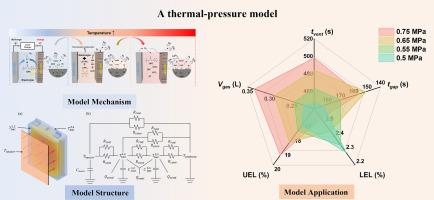A distributed thermal-pressure coupling model of large-format lithium iron phosphate battery thermal runaway
IF 10.1
1区 工程技术
Q1 ENERGY & FUELS
引用次数: 0
Abstract
The inner pressure that increases due to the complex physical and chemical reactions of batteries plays an important role in thermal runaway early warning and gas injection. However, most of the current thermal-pressure coupling models for batteries cannot accurately describe the gas generation sources and predict the inner pressure increases of multiple jelly rolls. In this work, we propose a thermal-pressure coupling model by combining the gas composition data and the fitting data from the accelerating rate calorimeter experiment. The electrolyte vapor pressure and internal gas composition are obtained under uniform heating conditions. The internal pressure growth source relies on the variation in the gas composition at different temperature ranges to infer. The reaction kinetics equations are then combined with gas generation sources, energy conservation equations and venting process to form a thermal-pressure model, which adopts a distributed structure to adapt to the temperature gradient between jelly rolls. The simulation results indicate that the model can accurately match the reaction gas accumulation phase before the valve venting, as well as the thermal runaway and cooling process temperature after the ejection. The simulation results indicate that when the pressure threshold increases from 0.5 MPa to 0.75 MPa, both the time-to-venting and time-to-peak temperature increase, but the interval between them decreases. Additionally, the explosion concentration range of the mixture gas also increases accordingly. This model revealed the inner pressure increase and thermal runaway process in large-format lithium iron phosphate batteries, offering guidance for early warning and safety design.

大型磷酸铁锂电池热失控的分布式热压耦合模型
由于电池复杂的物理和化学反应而增加的内压在热失控预警和气体注入方面发挥着重要作用。然而,目前大多数电池热压耦合模型无法准确描述气体产生源,也无法预测多果冻卷的内压增加。在这项工作中,我们结合气体成分数据和加速速率量热计实验的拟合数据,提出了一种热压耦合模型。在均匀加热条件下获得了电解质蒸汽压力和内部气体成分。内部压力增长源依靠不同温度范围内气体成分的变化来推断。然后将反应动力学方程与气体生成源、能量守恒方程和排气过程相结合,形成热压模型,该模型采用分布式结构,以适应果冻卷之间的温度梯度。仿真结果表明,该模型能准确匹配阀门排气前的反应气体积聚阶段,以及弹射后的热失控和冷却过程温度。模拟结果表明,当压力阈值从 0.5 兆帕增加到 0.75 兆帕时,排气时间和达到峰值温度的时间都会增加,但两者之间的间隔会减小。此外,混合气体的爆炸浓度范围也相应增大。该模型揭示了大型磷酸铁锂电池的内压增加和热失控过程,为预警和安全设计提供了指导。
本文章由计算机程序翻译,如有差异,请以英文原文为准。
求助全文
约1分钟内获得全文
求助全文
来源期刊

Applied Energy
工程技术-工程:化工
CiteScore
21.20
自引率
10.70%
发文量
1830
审稿时长
41 days
期刊介绍:
Applied Energy serves as a platform for sharing innovations, research, development, and demonstrations in energy conversion, conservation, and sustainable energy systems. The journal covers topics such as optimal energy resource use, environmental pollutant mitigation, and energy process analysis. It welcomes original papers, review articles, technical notes, and letters to the editor. Authors are encouraged to submit manuscripts that bridge the gap between research, development, and implementation. The journal addresses a wide spectrum of topics, including fossil and renewable energy technologies, energy economics, and environmental impacts. Applied Energy also explores modeling and forecasting, conservation strategies, and the social and economic implications of energy policies, including climate change mitigation. It is complemented by the open-access journal Advances in Applied Energy.
 求助内容:
求助内容: 应助结果提醒方式:
应助结果提醒方式:


